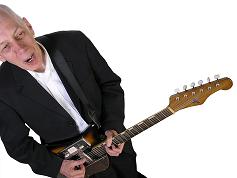|
Rod Clements saw considerable chart success with folk-rockers Lindisfarne, penning their hit Meet Me On The Corner. Now a solo artist, he is currently recording a new album. Rod is proud to have worked with the late, great Bert Jansch, and he continues to collaborate with various other musical kindred spirits including Michael Chapman, Rachel Harrington and Rab Noakes. We trust youíll enjoy the latest of Rodís regular musings in which youíll find heís
NICELY OUT OF TUNE

Have you been to a folk club lately? If you have, Iím willing to bet you remember pre-decimal currency and had at least one pair of flared jeans lurking in your wardrobe. And I bet you could say the same about most of the other people there. The trouble is, there donít seem to be many younger faces in the audience, and that must be a matter of concern to anyone who cares about real music at grassroots level. Folk clubs as we know them began in the 1950s, inspired variously by the traditional music revival, the skiffle boom and the politics of protest on both sides of the Atlantic. Though their musical policies ranged from a purist insistence on unaccompanied traditional songs to an inclusive welcome for just about any kind of music so long as it was played on acoustic instruments, they all shared a strongly non-professional ethos and an emphasis on local performers. They were, and are still, run by enthusiastic amateurs who work, unpaid, week in and week out, year after year, to present live music (and in the process help to provide a livelihood for a lot of performers).
Quite a few major artists started off in folk clubs. When my first band decided to opt for a more acoustic sound featuring our own original songs, it was to the folk clubs that we turned to test the water. Our part of the world was particularly well-endowed with such gigs; established singers from other parts of the country could come and do a weekís tour of the North East, playing a different venue every night.
Though by no means as ubiquitous as they once were, many folk clubs are now celebrating their fourth and fifth decades of activity. But they all face a problem: an ageing clientele, dwindling as older members retire and move away, and the absence of a younger audience coming in to take their place. Given the current resurgence of interest in folk music, and particularly the renaissance of traditional instrumental music among younger players, this is a bit of a mystery. After all, there are plenty of young artists out there. Thereís a highly-respected and well-subscribed degree course in folk music at Newcastle University and a plethora of opportunities to study part-time all over the country. And thatís before we even start on the young acoustic singer-songwriters who have less obvious musical connections with the traditional scene, but nevertheless interact readily with it.
Many of these younger players and acts regularly appear at folk clubs, which have always welcomed any sign of enthusiasm from the up-andcoming generation. So why doesnít that translate into a correspondingly younger audience?
Partly itís a problem of perception: young people donít go because itís not something young people go to. On several occasions Iíve seen a group of young players and their mates turn up at a club, wait in the other bar until itís their turn to play, come in and do their stuff and go away again without hearing the other artists or participating in the rest of the evening. Presumably, confronted with a roomful of grey hair, beards and people like their parents, they canít wait to get out again, but I canít help feeling theyíre being a bit disrespectful to their hosts. If I was running a folk degree course, Iíd make folk club attendance compulsory, backed up with detailed reports on each nightís proceedings.
You canít force young people into folk clubs, but at the moment both sides are missing out, and without a fresh intake, the clubs will eventually just fade away.
|